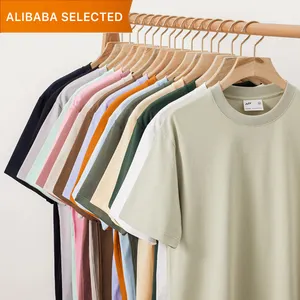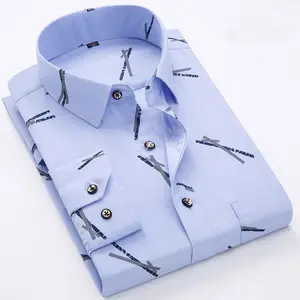(742930 products available)



































































































































































































Shirts are tops or garments worn on the upper part of the body. They are made of fabric and can be with or without sleeves. Most shirts have a neck opening which can be fastened or left open. It can be classified into different categories based on its styles and designs. Here are some of them:
Dress shirts
These are formal tops designed for business or special occasions. Usually, dress shirts are of a slim fit or regular fit. The slim fit is tailored to hug the body closely, while the regular fit provides more comfort because it does not hug the body closely. These shirts come in two types of cuffs, namely barrel cuffs and French cuffs. The barrel cuffs have buttons on them, while the French cuffs need cufflinks to fasten them. Dress shirts are mostly made of cotton, silk, or a blend of both. They come in different colors, though they are mainly neutral.
Casual shirts
Casual shirts are informal and can be worn for work or other activities. They have different styles, such as polo shirts, t-shirts, and henley shirts. Polo shirts have a collar and a few buttons. They are mostly worn for sports and have a casual look. T-shirts are simple, with short or no sleeves, and have a round or V-neck. The T-shirt can also have prints or designs on them. Henley shirts have a unique style with a buttoned placket and no collar. Casual shirts are made of cotton, linen, or synthetic fibers. Linen fibers are light and comfortable, which is why they are used during warm weather. Casual shirts are made in various colors and patterns.
Button-up shirts
Also known as button-down shirts, these shirts have buttons from the neck to the hem. They can be short or long-sleeved and have different collars. Button-up shirts are versatile and can be dressed up or down. For instance, they can be worn with jeans or dress pants. The difference between the two is that the button-down shirts have buttons on the collar to fasten the collar down to the shirt. These shirts can be made of cotton, flannel, or denim fabric. Flannel is warm and soft, so it is suitable for colder weather. Denim shirts are durable, which is why they are suitable for everyday use. It is available in solid colors, stripes, or checks.
Specialty shirts
These shirts serve specific purposes, like work or sports. For example, a chef's shirt is designed for cooking, and it is usually black or white. It has short sleeves and is made of cotton. Sports shirts are designed for different sports. For instance, a soccer shirt is made of breathable fabric, so the player does not sweat much. Some specialty shirts have unique features, such as moisture-wicking or UV protection. Moisture-wicking fabric draws sweat away from the body to keep the wearer dry. UV protection fabric helps to block the sun's harmful rays. These shirts come in various colors and designs to suit their purpose.
The design of shirts incorporates numerous components that work together to make a functional, comfortable, and stylish garment. Here are the essential elements of shirt design:
Style
The shirt's design incorporates its cut, style, and overall visual appeal. These aspects include the neckline shape, sleeve length, and body fit. The design communicates the intended use and aesthetic preferences. For instance, casual shirts often feature V or crew necklines, short or long sleeves, and a loose fit. In contrast, formal shirts may have tailored fits and specific details like French cuffs.
Fabric
The fabric affects the shirt's look and feel. Designers consider texture, weight, and drape. Cotton, linen, and blends are popular for their comfort and breathability. Silk and satin add luxury, while synthetic fibers offer durability and stretch. The fabric choice aligns with the shirt's purpose and season. For example, lightweight linens suit summer, while flannels are cozy in winter. The fabric's color and pattern also play a vital role in design. Solid colors, prints, and weaves add visual interest and style. Designers choose fabrics that enhance comfort and aesthetic appeal, ensuring the shirt meets the wearer's needs and preferences. A well-chosen fabric elevates a shirt's design, making it versatile and appealing to a broad audience.
Color
Color significantly shapes a shirt's design. It influences perception and mood. Designers choose colors based on trends, culture, and psychology. For instance, blue shirts often convey trust and professionalism. Red can signify passion or energy. The color palette can be vibrant, muted, or neutral, each evoking different feelings and responses. Additionally, color contrasts and combinations play a crucial role in creating visual interest and balance. They can highlight specific features or details in the shirt's design. Whether through solid colors, patterns, or color-blocking techniques, color remains a key element in shirt design. It transforms a simple garment into a statement piece or a classic wardrobe staple. This influences its appeal to diverse audiences and occasions. The choice of color can make a shirt stand out or blend seamlessly, offering versatility in styling and wear.
Pattern
Patterns add visual complexity and style to shirts. They range from classic stripes and checks to intricate florals and abstract designs. Each pattern brings a unique aesthetic and vibe to the shirt. For instance, striped shirts can offer a sleek, modern look. In contrast, floral patterns often evoke a more relaxed, casual feel. The choice of pattern influences the overall design and how the shirt pairs with other clothing. Patterns can be bold or subtle, depending on the desired impact. Designers consider color, scale, and repetition in creating patterns. These elements determine how the pattern interacts with the shirt's cut and fabric. Patterns can transform a simple shirt into a statement piece. They attract attention and express individuality. Whether through playful prints or sophisticated patterns, design patterns are integral to contemporary shirt design. They enhance versatility and style, catering to various tastes and occasions.
Details and Finishing
Details and finishing touches refine a shirt's overall appearance. They enhance its functionality and aesthetic appeal. These elements include buttons, stitching, hems, and trims. Each contributes to the shirt's design and quality. For instance, buttons can be chosen for their size, shape, and material. They add visual interest and serve as practical fastenings. Similarly, precise stitching techniques ensure durability and create decorative patterns. Hems can be finished in various ways, such as with double stitching or bias tape. This ensures a neat and lasting edge. Additional details like pockets, pleats, and cuffs further enrich the shirt's design. They offer both style and practicality. These components are often carefully considered and crafted. They align with the shirt's overall design concept. This ensures a cohesive and polished look. Whether in casual or formal shirts, details and finishing play a crucial role in elevating the garment's appeal and functionality. This enhances its attractiveness and wearability.
Shirts have a wide range of wearing and matching suggestions.
Wearing tips
Wearers should match the shirt with pants or skirts to achieve a stylish appearance. One can layer the shirt with a blazer or sweater for a formal look. For casual wear, users should pair the shirts with jeans or chinos. To achieve a professional outlook, users should choose tailored trousers or a pencil skirt. Additionally, users should accessorize their shirts with a statement necklace or scarf. Users should tuck in the shirt for a polished appearance or leave it untucked for a relaxed vibe.
Matching suggestions
Users should pair plain, solid-colored shirts with jeans or khakis for a classic look. Additionally, users should pair striped or checked shirts with solid-colored bottoms. Further, users should match white shirts with almost any bottom. More importantly, users should combine black shirts with lighter-colored bottoms. Luckily, users should match pastel-colored shirts with neutral tones. Also, users should pair bright-colored shirts with darker bottoms to balance the outlook. Similarly, users should combine graphic tees with jeans or shorts for a casual look.
Formal occasions
Shirts are worn on formal occasions. For example, white and blue shirts are worn on formal occasions. Also, button-down shirts are worn on formal occasions. Additionally, tailored shirts are worn on formal occasions. More importantly, dress shirts are worn on formal occasions. Also, fitted shirts are worn on formal occasions. Further, long-sleeved shirts are worn on formal occasions. Regular-fit shirts are worn on formal occasions. Additionally, polo shirts are worn on formal occasions. More importantly, silk and cotton shirts are worn on formal occasions.
Casual occasions
Casual occasion shirts include graphic tees, denim shirts, and flannel shirts. Additionally, chambray shirts and polo shirts are also included. More importantly, tank tops and sleeveless shirts are included. Regular-fit shirts and oversized shirts are also included. Further, hooded shirts and sports jerseys are included. Button-up shirts and crop tops are included as well.
Q1: What are the different types of shirts?
A1: Shirts come in various types, including dress shirts, casual shirts, polo shirts, and T-shirts each serving different purposes and contexts. For example, dress shirts are formal and usually have long sleeves, while casual shirts can be short or long-sleeved and made from various fabrics like cotton or linen.
Q2: What fabrics are commonly used for shirts?
A2: Shirts are made from an array of fabrics, including cotton, linen, polyester, silk, and blends. Each fabric has unique characteristics; for instance, cotton is breathable and versatile, while silk offers a luxurious feel. Polyester shirts are known for their durability and wrinkle resistance.
Q3: How does one choose the right shirt size?
A3: To choose the right shirt size, one should measure their neck, chest, and waist and compare the measurements to the sizing chart provided by the brand. Pay attention to sleeve length for a comfortable fit. Some brands offer slim, regular, and relaxed fits to cater to different body types.
Q4: Are there sustainable options for shirts?
A4: Yes, many brands offer sustainable shirt options made from organic cotton, recycled fabrics, or eco-friendly production processes. These options cater to consumers looking for environmentally conscious choices without compromising quality and style.
Q5: How should shirts be cared for to ensure longevity?
A5: To ensure longevity, shirts should be cared for by following specific washing instructions, such as using cold water for cotton and polyester blends and hand washing silk. Avoiding high heat in dryers and opting for air drying or low heat settings helps maintain the fabric's integrity and prevent shrinkage.